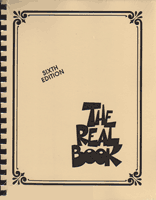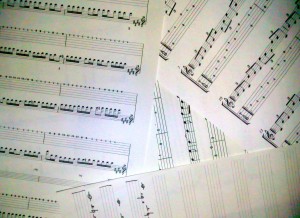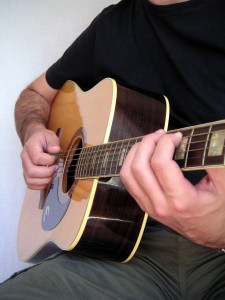- It’s better to practice 30 minutes a day than 10 hours once a week.
- Take frequent breaks, distract your mind to then go back and give full attention to what you are doing. Usually 45 minutes practice followed by15 minutes break works for me.
- Always warm up and stretch before playing for hours. Start slow with some technical exercises. I did a theatre gig for 3 years that had a 15 minute band call. I used that to warm up with different technical exercises, and I was shocked how just those 10 minutes every day gave a massive boost on my speed and articulation. 10 minutes!
- I find that practising tunes (playing actual music) is better than spending hours practising technical exercises. Those are great to warm up. Composing new tunes, finding new ideas , learning and transposing tunes in all keys are by far the best things you can do when practising.
- Try playing/practising in the dark (pitch black room or blindfolded). You will become more musical and less dependent on ‘visual patterns’. John Scofield used to do this all the time.
- Keep a basic setup ready to go at all times (if you can at home), this is great for impromptu sessions, when you are more inspired to write/record/practice without loosing momentum by trying to find picks and cables.
- Record your practice sessions and listen back after a few days to find what you can improve. If you practice with a computer or a phone, video your sessions and you’ll find also you can correct postural problems or see if your performance is visually boring!
- Practising should not be a boring task. If you find it boring, don’t do it. You should be curious/excited about improving.
- It is better to practice with a friend than along to backing tracks. Invest in a looper pedal (they can be super cheap these days), it can be fun and beats playing to a backing track. Playing along to tracks is not bad, but I find that after a while it’s easy to loose focus and just ‘noodle’. If you practice to tracks, take a short break after each one, don’t let one roll into the other.
- Change your practice routine often. Just like working out at the gym, your body gets used to doing the same exercises and stops reacting. Rotate different exercises/tunes/tasks.
Tag: Practicing
Funk Guitar Comping Tips Pt2 Ghost Notes and Muted Notes
We have seen how in the previous ‘Funk Tips’ video we can build a simple line and make it Funky…here I show example using muted notes and ghost notes. Simple but effective, and it’s all about the feel, so listening to the masters is a must.
Factorial Thinking (Combinations applied to music)
Today’s’ tip has to do with mathematics applied to music…we have already seen how in the finger combinations exercises we have used all the possible combinations of 2,3 and 4 fingers of our left hand to make sure we cover every possible motion. This is not only a great warm up and technical exercise, but also a way to keep your brain connected.
Let’s see how we can now apply this to notes, chords, arpeggios, and so on. These are the combinations we have see in the previous post:
Finger combinations (combinations of all numbers from 1 to 4 as left hand fingers are numbered that way on guitar)
12 13 14
21 23 24
31 32 34
41 42 43
123 124 132 134 142 143
213 214 231 234 241 243
312 314 321 324 341 342
412 413 421 423 431 432
1234 1243 1324 1342 1423 1432
2134 2143 2314 2341 2413 2431
3124 3142 3214 3241 2413 2431
4123 4132 4213 4231 4312 4321
Let’s apply this to a 7th arpeggio: I will replace all the 2 with 3s, the 3 with 5s and the 4 with 7s.
Combinations applied to Chord Tones
13 15 17
31 35 37
51 53 57
71 73 75
135 137 153 157 173 175
315 317 351 357 371 375
513 517 531 537 571 573
713 715 731 735 751 753
1357 1375 1537 1573 1735 1753
3157 3175 3517 3571 3715 3751
5137 5173 5317 5371 3715 3751
7135 7153 7315 7351 7513 7531
Let’s make an example in the key of C: this is Cmaj7 every possible combination of the four notes.
Combinations applied to Chord Tones of Cmaj7
CE CG CB
EC EG EB
GC GE GB
BC BE BG
CEG CEB CGE CGB CBE CBG
ECG ECB EGC EGB EBC EBG
3GCE GCB GEC GEB GBC GBE
BCE BCG BEC BEG BGC BGE
CEGB CEBG CGEB CGBE CBEG CBGE
ECGB ECBG EGCB EGBC EBCG EBGC
GCEB GCBE GECB GEBC EBCG EBGC
BCEG BCGE BECG BEGC BGCE BGEC
Obviously this is not music as such, but I always find that incorporating things like these in your daily practice routine can lead you to discover new material, or just find faults to fix in your playing. As an example go through the combinations and find a combination you like and that sounds more musical to you…play in all 12 keys, apply it to a tune like ‘Autumn leaves’ taking it around the changes and modifying it to match the chord of the moment.
Good luck!
A list of the most popular jazz standards

This post if for the jazz guys, and possibly those that want to venture into jazz territory. I talked about repertoire yesterday, and today I was asked by a friend to put together a list of the most popular jazz standards that might be called at a jam session…this is what I came up with, and I thought of sharing it with you. Comes without saying that this list is by all means incomplete and dictated by my experience with jazz jams. Feel free to add your suggestion in the comments section!
A Nightingale Sang In Berkeley Sqare
Agua De Beber
Ain’t Misbehavin’
All Blues
All of Me
All of You
All Or Nothing At All
All the Things You Are
Alone Together
Angel Eyes
Autumn Leaves
Beautiful Love
Billie’s Bounce
Blue Bossa
Blue Monk
Blue Moon
Body and Soul
But Not For Me
Bye Bye Blackbird
C Jam Blues
Caravan
Chelsea Bridge
Cherokee
Come Rain Or Come Shine
Cry Me a River
Darn That Dream
Days of Wine and Roses
Desafinado
Do Nothin’ Till You Hear From Me
Don’t Get Around Much Anymore
Donna Lee
Doxy
Easy to Love
Embraceable You
Estate
Everything Happens to Me
Everytime We Say Goodbye
Fly Me To The Moon
Foggy Day
Four
Gee Baby Ain’t I Good to You
Gentle Rain
Georgia On My Mind
Giant Steps
Girl From Ipanema
God Bless the Child
Good Bait
Green Dolphin Street
Have You Met Miss Jones
Here’s That Rainy Day
How Deep is the Ocean
How High the Moon
How Insensitive
How Long Has This Been Going On
I Can’t Get Started
I Could Write a Book
I Didn’t Know What Time It Was
I Get a Kick Out of You
I Got Rhythm/Rhythm Changes
I Hear a Rhapsody
I Loves You Porgy
I Remember You
I Should Care
I Thought About You
I’ll Remember April
I’ve Got You Under My Skin
If I Should Lose You
If I Were a Bell
Impressions
In A Sentimental Mood
Invitation
Isn’t It Romantic
It Ain’t Necessarily So
It Could Happen to You
It Don’t Mean A Thing
It Had to Be You
Jitterbug Waltz
Joy Spring
Just Friends
Just One of Those Things
Killer Joe
Lady Is A Tramp
Laura
Lazy bird
Like Someone In Love
Love For Sale
Lover Man
Lullaby Of Birdland
Lush Life
Mack the Knife
Maiden Voyage
Mercy, Mercy, Mercy
Misty
Moanin’
Mr. P.C.
My Favorite Things
My Foolish Heart
My Funny Valentine
My Little Suede Shoes
My One and Only Love
My Romance
Nardis
Nature Boy
Night and Day
Night In Tunisia
Now’s The Time
Old Devil Moon
Old Folks
Oleo
On A Slow Boat To China
On The Sunny Side Of The Street
One Note Samba
Over The Rainbow
Polka Dots and Moonbeams
Prelude To A Kiss
Quiet Nights of Quiet Stars (Corcovado)
Round Midnight
Satin Doll
Scrapple From The Apple
Smile
Smoke Gets In Your Eyes
So What
Softly as In A Morning Sunrise
Solar
Someday My Prince Will Come
Someone To Watch Over Me
Somewhere Over the Rainbow
Song For My Father
Sonnymoon For Two
Speak Low
St. Thomas
Stella By Starlight
Stormy Weather
Straight No Chaser
Sugar
Summertime
Sunny
Sweet Georgia Brown
Take Five
Take the “A” Train
Tea For Two
The Man I Love
The Nearness of You
The Night Has 1000 Eyes
The Shadow Of Your Smile
The Very Thought of You
The Way You Look Tonight
There is No Greater Love
There Will Never Be Another You
They Can’t Take That Away From Me
Things Ain’t What They Used to Be
This Masquerade
Time After Time
Tune Up
Watermelon Man
Wave
Well You Needn’t
What is This Thing Called Love
When I Fall In Love
When Sunny Gets Blue
Work Song
Yesterdays
You and the Night and the Music
You Don’t Know What Love Is
You’d Be So Nice To Come Home To
The Importance of Repertoire
 In this short post I want to spend a few words on the importance of knowing tunes, either written by other musicians or by yourself. ‘Repertoire’ is often a fancy word we use to identify ‘all the tunes we know’.
In this short post I want to spend a few words on the importance of knowing tunes, either written by other musicians or by yourself. ‘Repertoire’ is often a fancy word we use to identify ‘all the tunes we know’.
In my experience as teacher I have found to be a divide between the guitarist that is obsessed by theory and scales and that who is just interested in learning songs with no real interest in knowing how this songs are created. I always wondered why the second category were happier about their playing…
We spend as musicians most of our time learning theory, techniques and we often wonder how these fit in with ‘real life’….a lot of times we forget that tunes and musical pieces/compositions should be the goal of what we do. All these exercises and music theory studies should be a way to better perform and understand the tunes we know and write.
I always suggest to all my students to always keep an updated list of all the tunes they know (or they can busk), and a folder with all their original material, from the completed tunes to the ‘work in progress’ type material.
Keep writing and learning new tunes: this will give you a sense of purpose in your studies and also it will be a test for all the techniques and theory you have learnt…
Good luck!
